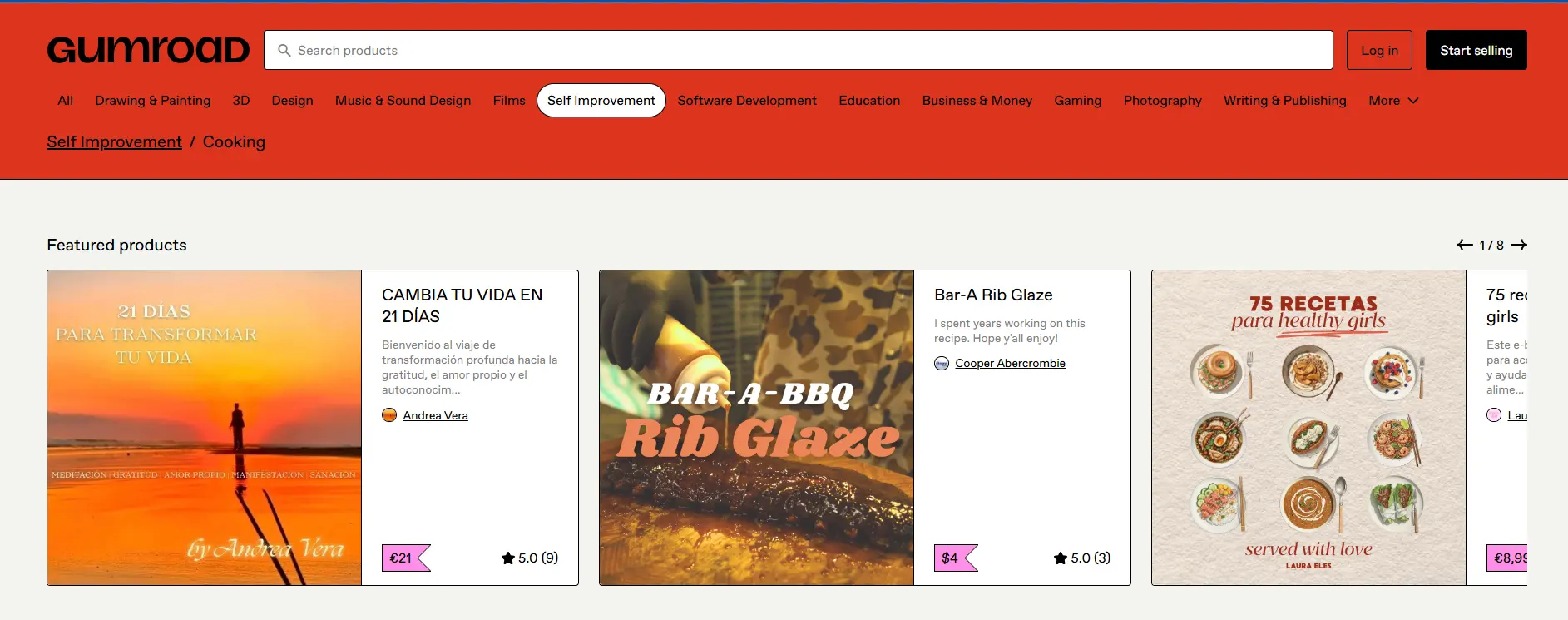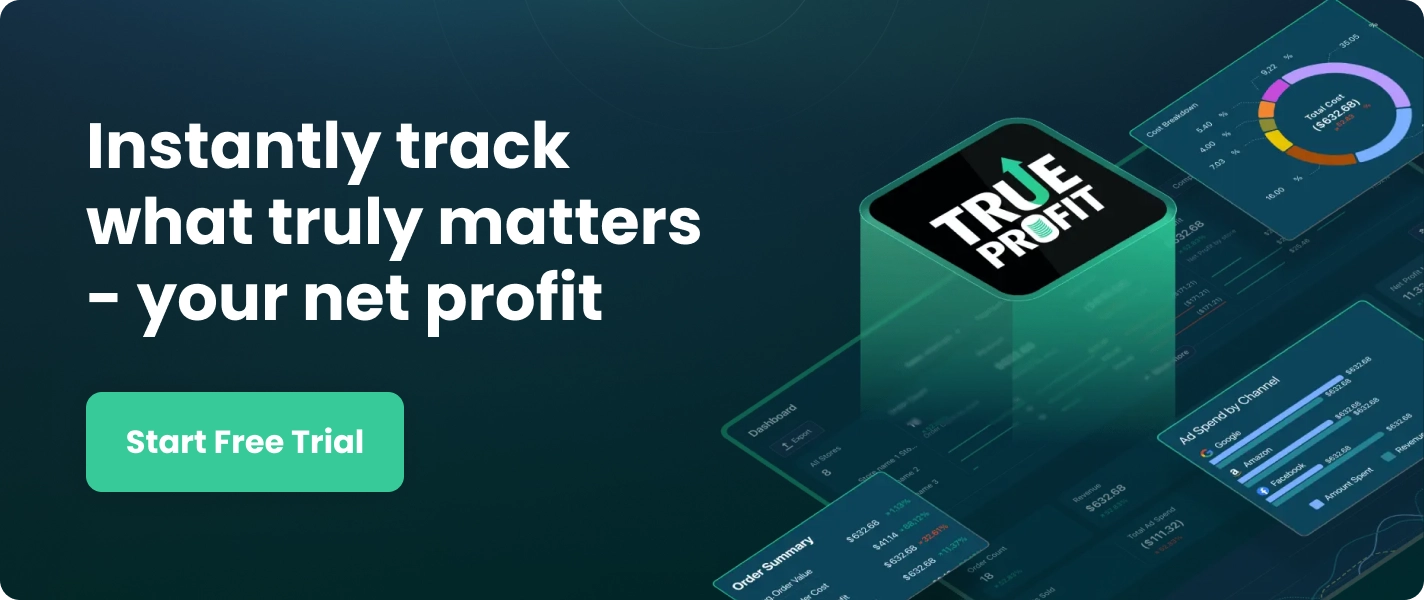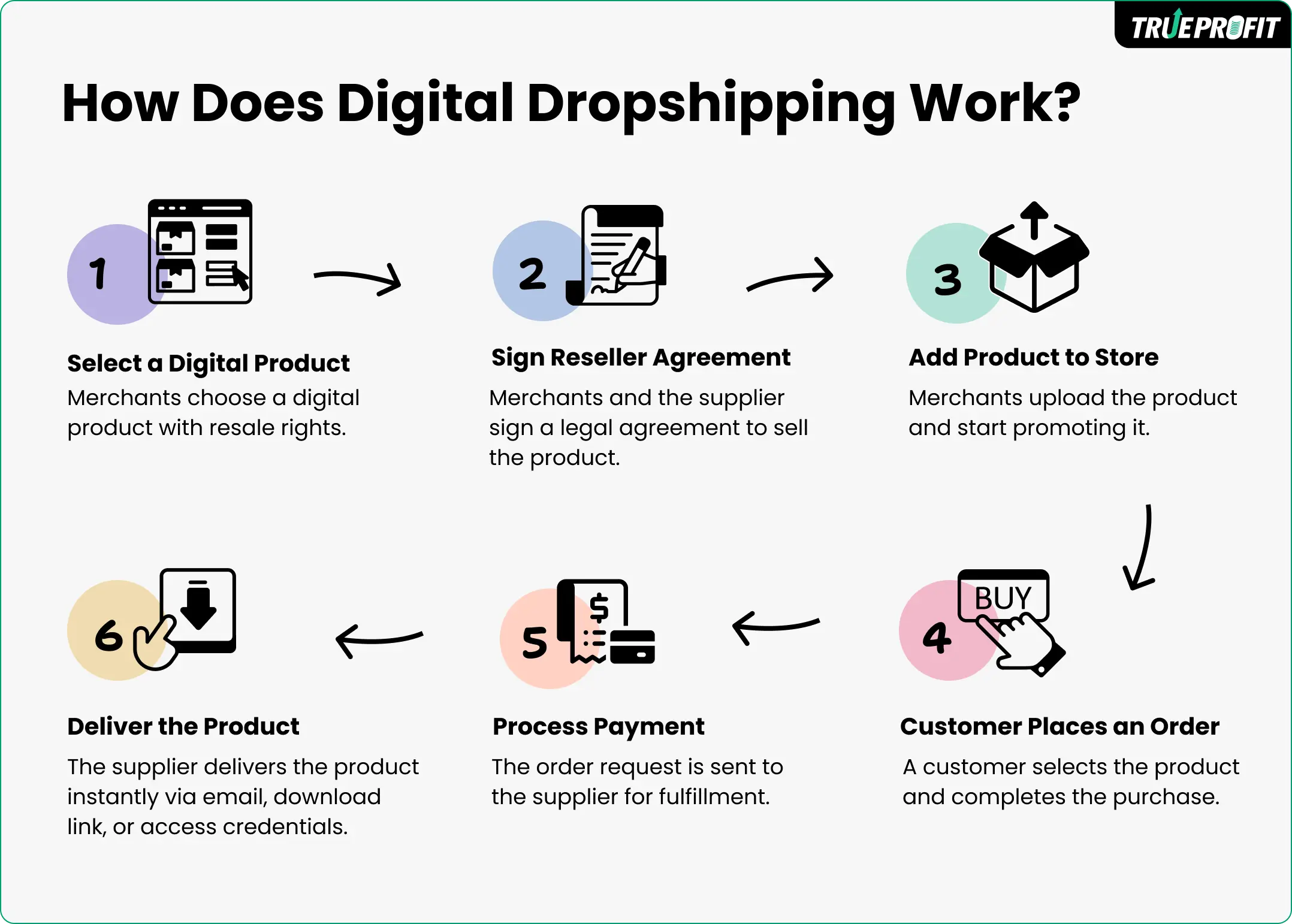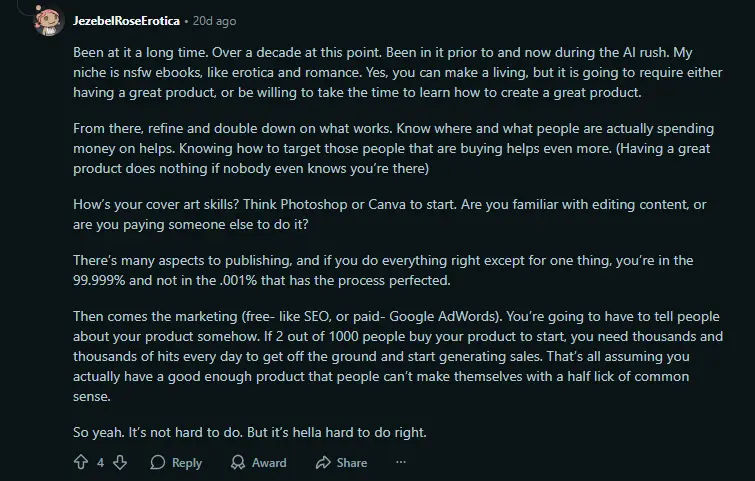Digital Dropshipping: How to Start It Profitably in 2026

Digital dropshipping is one of the lowest-risk and the most cost-efficient business ideas in eCommerce. In this guide, we’ll walk you step by step through everything you need to start a profitable digital business—from picking the right niche to tracking true profitability of your store.
Let’s dive in.
What is Digital Dropshipping & How Does It Work?
Digital dropshipping is a modern business model where merchants sell digital products without holding inventory. Top common digital items could be ebooks, software, online courses, and multimedia files. When a customer purchases a product from a store, it's usually delivered instantly by a third-party supplier via email or download link.
Here’s what’s different from a traditional digital product store: Merchants selling in this model do not own the rights to the products; instead, they enter agreements with creators/suppliers to resell their ready-made digital products.
Essentially, it works like this: you purchase a DFY digital product from a creator or supplier and list it for sale in your online store. When a customer purchases the product, the supplier or creator delivers it directly to the customer, while you earn the profit margin.
How to Start a Profitable Digital Dropshipping Business?
Starting a profitable digital business in 2026 requires careful planning and strategic execution. Here’s a step-by-step guide:
Step 1: Choose a Potentially Profitable Digital Niche
To build a successful digital store, merchants should carefully start with a niche. A niche clearly defines the target audience and helps identify ideal products for potential customers.
Popular niches in 2026 include:
- Personal development courses
- Productivity eBooks
- Printable wall art
- Graphic design templates
- Website themes
- Stock photos
- Custom digital avatars
That said, there is no one-size-fits-all best niche. The key is to strategically pick niches with good profit margins and consistent buying demand.
For beginners, there’s no need to overcomplicate—simply start with one you understand, have some interest or passion for, or have connections in. Ideally, it’s a niche where the seller is also part of the target audience, making it easier to promote products effectively.
Remember, you don’t need to marry a single niche upfront. By testing 2–3 products per category with a controlled ad budget , you can gradually identify what sells. The niche often becomes clearer naturally after the first sales rather than before launching.
Step 2: Choose the Right Product to Sell
For the quick start, here are examples of top high-demand digital products for 2026:
- Canva templates
- Printable planners & journals
- Lightroom presents & filters
- Digital art & stickers
- Mini tutorials
- Music loops
- Web templates
- Coding snippets
- Sound effects


But if you want to research and validate products yourselves, there are a few essential factors to consider:
First, the product should consistently maintain steady demand, meaning there’s an active audience continuously seeking it without oversaturation.
Second, products should ideally offer high recurring potential—they can be sold repeatedly for ongoing revenue and repeat purchases.
Third, it should have clear licensing. Clear licensing is equally important to ensure full legal compliance in digital dropshipping.
Once these criteria are met, the product is generally worth testing in the store. However, stopping there won’t accurately reveal its true profitability. Most merchants go further by carefully monitoring its profit margin performance during the first few weeks.
During this time, the goal is to evaluate whether the product truly delivers strong net profit margins—it’s the most accurate indicator of a profitable item and helps make smarter decisions about scaling, optimizing pricing, or moving on to the next idea.
Step 3: Work with Reliable Suppliers
To simplify the search, merchants can use secure platforms to find reliable suppliers such as Gumroad, Payhip, Eacons, Creative Fabrica, Creative Market, Shopify Collective, Etsy, and FilterGrade.


While scrolling through those platforms, keep in mind top four factors:
The most important factor when choosing a digital supplier is clear licensing that explicitly allows resale. This is the first and non-negotiable check, as it protects merchants from complex legal issues that can arise in business.
Next, the product quality and delivery reliability are crucial—these two factors can make or break the success of a digital dropshipping business.
The supplier should also support seamless integration with the merchant’s store, making order processing and product delivery effortless.
Once these criteria are confirmed, merchants should check the supplier’s bulk pricing and minimum order requirement since keeping COGS low is key to maintaining healthy profit margins.
Finally, merchants should always watch out for common supplier scams, as it happens a lot and there’s no guarantee you won’t become the next victim. Some middlemen may pose as the real supplier or payments might be requested outside secure platforms. These risks are widespread in the digital market, so protect yourself by learning how to read red flags and the proper steps to take if one occurs.
Step 4: Select Where to Sell
Digital dropshippers can sell their products across marketplaces like Gumroad and Etsy, or build their own stores using platforms like Payhip and Shopify. Both approaches have their pros and cons.
Marketplaces are ideal for beginners because they offer low fees and lots of internal traffic, but their audiences often expect lower prices, making it more challenging to generate significant profit.
On the other hand, Payhip is designed specifically for building digital product stores, while Shopify offers merchants deeper control and more extensive app integrations to scale professionally.
The better approach is to combine both. Most merchants often start with free or low-cost platforms like Gumroad to quickly test ideas and validate demand. Once they confirm that people are willing to pay for their products, they often switch to Shopify to build a full storefront.
Step 5: Set up Automated Tools
There’s no need for packaging or shipping logistics. So merchants rely on specialized apps that connect directly to their store to upload, sell, and deliver digital products instantly. Top tools for this include Easy Digital Products (EDP), Filemonk, and SendOwl.
For all remaining tasks, merchants can use automated solutions just like in traditional dropshipping:
- Creatify is best for ad creation
- Tidio is best for automated customer support.
- Kaviyo is top solution for email marketing automation
- TrueProfit is the best for Shopify net profit analytics.
Step 6: Market and Grow Your Store
For a new store, the top priority is to get that first sale, and there’s no faster way to achieve it than using paid advertising. While it can be costly, paid ads often deliver the quickest results. Currently, Facebook is the most favored ad platform among dropshippers thanks to its massive user base and an average click through rate of 2.5% across industries.
However, relying solely on paid ads is not a sustainable long-term strategy. Merchants should drive store traffic from multiple sources including SEO, social media, online communities, LLMs, and email campaigns. The goal is to create a consistent stream of high-intent visitors even when paid ads performance suddenly drops.
Top Benefits of Running a Digital Dropshipping Business in 2026
This model offers numerous advantages over traditional eCommerce models:
1. Low Startup Costs
Digital dropshipping is one of the most cost-efficient eCommerce models in 2026. Here’s an average cost benchmark between a traditional dropshipping store vs. a general digital store:
While a traditional Shopify dropshipping store can cost $3,000–$10,000 before first sales, digital dropshipping can start with as little as $1,500–$5,000.
Merchants save significantly since there are little-to-no costs for packaging, fulfillment, or shipping. This can make digital stores 40–60% cheaper to start than traditional ones, making it an ideal low-risk option for newcomers to eCommerce.
2. Passive Income Potential
Heads up: It’s definitely the pros, just not quite as you’d expect.
We actually like to call digital stores a semi-passive income model, since stores can operate mostly automatically once set up but that doesn't mean you merchants do nothing at all. Running any business yourself already requires a hella lot of work!
But here's why we still call it a passive income opportunity: compared to a physical store or a 9–5 job, income can happen 24/7 without you being there. It allows most orders to be fulfilled automatically once your store is launched and automated delivery tools are properly set up.
However, there’s still a lot of work behind the scenes: providing customer support, constantly optimizing store layout, and most importantly, promoting your products through SEO, social media or paid ads. These tasks never fully disappear, even in fully automated dropshipping, merchants are still the one analyzing insights and making the final decisions.
In fact, the first few years are when a lot of work is needed due to no extra staff and little experience. It's common to end up working 80+ hours per week before seeing modest profits.
Saying this not to scare you, but to set realistic expectations many gurus skip. So what’s next? We recommend setting up a realistic upfront budget and maintaining a stable income stream to reinvest into your store.
3. Instant Delivery
One of the biggest advantages of this model is that customers get what they want almost immediately after purchase is completed in store, without the long 5-7 day shipping commonly seen in traditional dropshipping.
This instant delivery removes the whole “changed my mind while waiting” problem that kills traditional dropshipping orders. When people get what they paid for right away, they’re far more likely to finish the checkout — and way less likely to cancel.
4. High Gross Profit Margins
Once you buy the license or rights to a digital product, you can resell it potentially hundreds or thousands of times without additional cost. More importantly, the total cost can stay low thanks to no need for shipping or handling returns.
That’s why digital stores can hit crazy-high gross margins, about 75% to 85% on a good product. That’s already higher than the industry’s 50–70% average gross margin range.
5. Simplified Logistics
One of the easiest parts of a digital store is definitely the logistics especially when the automation tools are properly set up. There's no inventory to keep, no boxes to pack, and no complicated delivery issues to deal with (of course, technical issues might occasionally occur, but overall it's much way simpler than running a physical store).
The Biggest Challenges of Digital Dropshipping
Despite its benefits, digital store comes with challenges:
1. Licensing and Copyright
You can only sell what you have the legal right to sell. This means you need to make absolutely sure the digital products you’re offering are legally licensed for resale first. Using someone else’s work without permission can lead to serious legal trouble, or even force your store to shut down.
2. High Competition
The market is fiercely competitive, not just among creators, but also big merchants and other dropshippers selling the same products as you. Popular niches—like social media templates, stock photos, or ebooks—can quickly become saturated with dozens or even hundreds of sellers offering nearly identical products.
Is Digital Dropshipping Profitable in 2026?
Digital dropshipping is a promisingly profitable business idea especially when more and more people are consuming digital content nowadays, making it always a hot market. Last year, the global content market pulled in $32.28 billion—and this market report predicts revenue will nearly double ($69.80 billion) in the next six years.
Stickers, ebooks, and similar products consistently sell well, proving there’s strong potential if merchants carefully pick the right niche and products. With very low supplier costs and almost no shipping, gross margins can reach 60–75%.
Overall, merchants have full potential—strong demand and healthy gross margins for running a successful store. That said, at the individual store level, it’s still too early to confidently claim that your store is 100% guaranteed profitable. To claim that, you need to look at your real-life net profit—the ultimate measure of a store’s profitability.
A positive net profit means your store is profitable, but understanding it requires actually running the store and consistently tracking net profit alongside other financial metrics over time.
Track True Performance of Your Digital Dropshipping Business
Net profit is the most accurate measure of your store’s profitability, as it accounts for all expenses—including cost of goods sold, ad spend, platform fees, transaction costs, and other hidden expenses. In other words, net profit reflects your true income from running a digital dropshipping business.
That said, tracking net profit isn’t simple. With multiple ad channels, apps, and providers, doing it manually or via spreadsheets is time-consuming and prone to errors.
TrueProfit, the #1 net profit analytics solution for Shopify dropshippers, provides the most accurate net profit tracking thanks to its comprehensive integration with dropshipping platforms and marketing channels.
With TrueProfit, merchants can:
- Real-time Profit Dashboard: Keep track of the most critical financial metrics including net profit, revenue, COGS (product cost), shipping cost, ad spend, total cost, net profit on ad spend, customer lifetime value, customer acquisition cost, and more - all in one real-time dashboard.
- Profit Per Product Tracking: Identify the most and least-profitable products by tracking net profit per item.
- Multi-Channel Ad Performance Tracking: Measure true impact of every marketing channel and spot the top & low-performing ad campaigns after all costs. Seamless integration with major ad platforms like Facebook, Instagram, Google, TikTok, and more.
- PnL Performance Report Over Time: Reveal profit & loss change with other financial metrics performance over time — by week, month, or year.
- Customer Value Tracking: Spot true value of customers by comparing the return per acquisition cost.
- Mobile Profit Dashboard: Stay on top of your store's profit and costs on the go.


TrueProfit helps you understand your real profit and loss in real-time, empowering you to make data-driven decisions and confidently scale your dropshipping business in 2026.
Final Thoughts
Digital dropshipping in 2026 is an exciting opportunity for entrepreneurs seeking low-risk, high-margin online businesses. With the right niche, product, and tools, you can build a profitable store that generates passive income while minimizing logistics headaches.
Leah Tran is a Content Specialist at TrueProfit, where she crafts SEO-driven and data-backed content to help eCommerce merchants understand their true profitability. With a strong background in content writing, research, and editorial content, she focuses on making complex financial and business concepts clear, engaging, and actionable for Shopify merchants.







